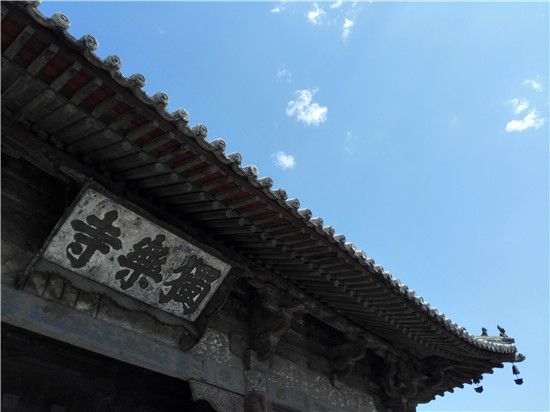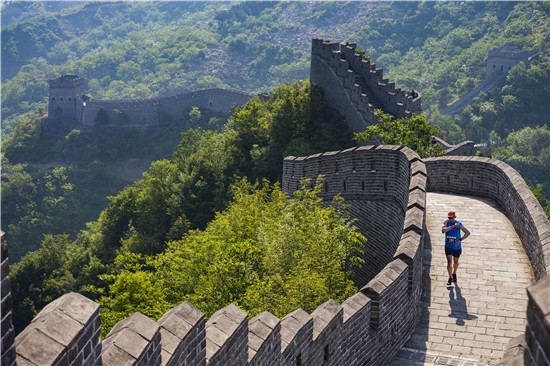Tianjin altogether is one of the largest, widespread regions in China. Of the 16 districts that make up its number, only seven are attributed to urban Tianjin, leaving a lot of room to explore beyond the concrete jungle. Travel an hour or more from the bustle of big city life in Tianjin and discover vast mountain ridges, excellent hiking trails, and of course, the Great Wall of China itself. It is Ji County, known as the back garden of Tianjin. The area has many historical relic sites and beautiful natural scenery. It has become the best getaway for Tianjiners on weekends and other major holidays.
Many local tourists book rural village inns just to enjoy the quietness and fresh air in the mountain. But if you only have a few days in Tianjin, you can book a one-day trip to Ji County and visit some well-known sites.
Dule Temple
 |
| The entrance of Dule Temple |
Built during the Tang Dynasty (seventh to tenth century) and rebuilt in 984 AD, Dule Temple (独乐寺) — also known as the Temple of Solitary Joy — is one of China's oldest surviving wooden structures. Two of the Buddhist Temple's oldest structures also rank among the oldest.
Dule Temple was established in the early period of the Xuanzong reign in the Tang Dynasty (618-907). An Lushan, the prefecture military governor, gave oath there to rebel against the Tang Dynasty by launching the An Lushan - Shi Siming Rebellion.
Solitary Joy Temple consists of east, west and central parts, with monks rooms and Xanadus in the east and west parts, and the temple gate and the Kwan-yin Pavilion in the central part. According to historical record, in the second year (984) of the Tonghe reign, the temple was rebuilt. Except the temple gate and Kwan-yin Pavilion built in the Liao Dynasty (916-1125), other buildings in the temple were all built in the Ming and Qing Dynasties (1368-1911).
The gate of Dule Temple built on low-lying stairs is 16.57 meters long. Two earthen statues of Fierce-Looking Guards stand as the gatekeepers in both sides of the pylon. The temple gate has a single-eaved palace roof, the earliest roof of its kind extant today in China.
Passing the temple gate through stairs up to the north, there is a three-storey pavilion. It is the oldest extant pavilion architecture in China. On the pedestal at the center of the pavilion stands a Kwan-yin statue of 16-meter height.
 |
| The Kwan-yin Pavilion of Dule Temple |
The Kwan-yin Pavilion is centered on the statue and surrounded by two rows of pillars. The roof beams are settled around the statue, and there is an octagonal sunk panel over the head of the statue. The four walls of the pavilion's first floor are all decorated with color frescoes, whose subject matters include 16 standing Arhats, a Buddha with 3 heads and 6 arms, the Ming King with 4 arms, sceneries and folk customs, which are all masterpieces done by famous painters in the Yuan and Ming Dynasties (1271-1644).
Dule Temple was reconstructed and repainted during the Wanli reign of the Ming Dynasty (1368-1644), the reigns of emperors Shunzhi, Qianlong and Guangxu of the Qing Dynasty (1644-1911).
Dule Temple is the representative work of ancient Chinese wooden architecture, and its superb architectural techniques has made it get through many intense earthquakes but still stand there intact. Dule Temple underwent several repairs after the founding of new China and is relatively well preserved now.
Huangyaguan Great Wall
 |
| The Huangyaguan Great Wall |
Located in the mountainous area of Tianjin's northern Ji County, the Huangyaguan Pass was first built during the Northern Qi Dynasty (550 - 557) and repaired in large scale with bricks during the Ming Dynasty (1368 - 1644). When appointed as the chief commanding officer in the Ji Garrison (one of the eleven garrisons of the Ming Dynasty), Qi Jiguang added watch towers and other defensive works.
The pass comes out first in the ten most-visited sites in Tianjin. It is considered to be a miniature of Chinese Great Wall. The entire section is built on an abrupt mountain ridge. Being endowed with both natural beauty and cultural interest, it has become famous as a natural beauty spot and a summer resort. The major scenic area is composed of the pass itself and Taiping Mountain Stronghold.
Huangyaguan Pass In 1984, the people of Tianjin spent three years repairing 3,308 yards of the main wall from Banlagang Mountain in the east to Wangmaoding Mountain in the west. They restored 20 terraces, the Huangya Water Gate, and the Bagua Castle (the Eight Diagrams Castle). The defensive system of the wall is complete. Watch towers, frontier cities, drain holes, emplacements, barracks and other indispensable military facilities are arranged orderly along the wall. Besides, the stele forests of the Great Wall, Beiji Temple, the exhibition hall of famous couplets, the Great Wall Museum (the first museum along the wall and the Phoenix Fortress have been newly built within the area.
Taiping Mountain Stronghold Six miles northwest of Huangyaguan Pass and built 437 yards to 547 yards above sea level, the stronghold is located in Xiaopingan Village. It controls the Chongshan Valley east of the pass. Qi Jiguang's stone statue and a tower were erected by twelve widows from this area. Huangyaguan Pass welcomes tourists from all over the world, including many runners, who participate in the annual international Great Wall Marathon.

 Culture
Culture




